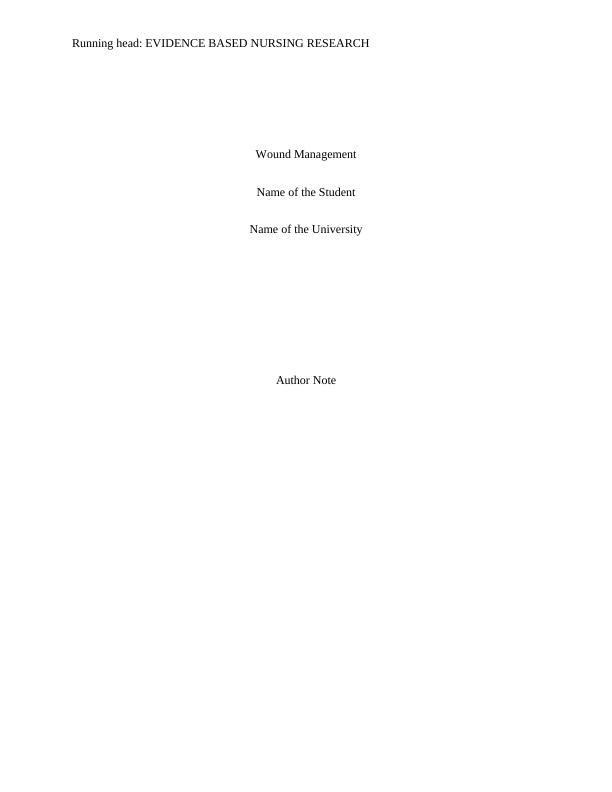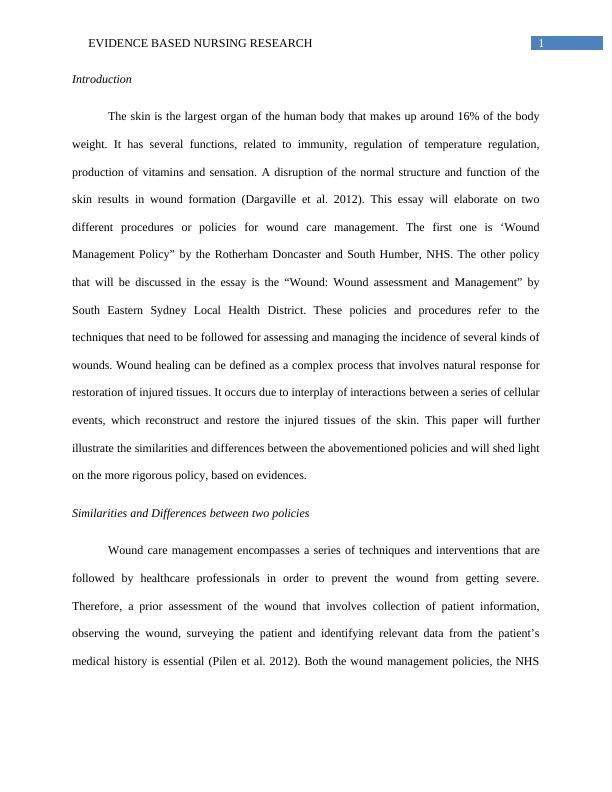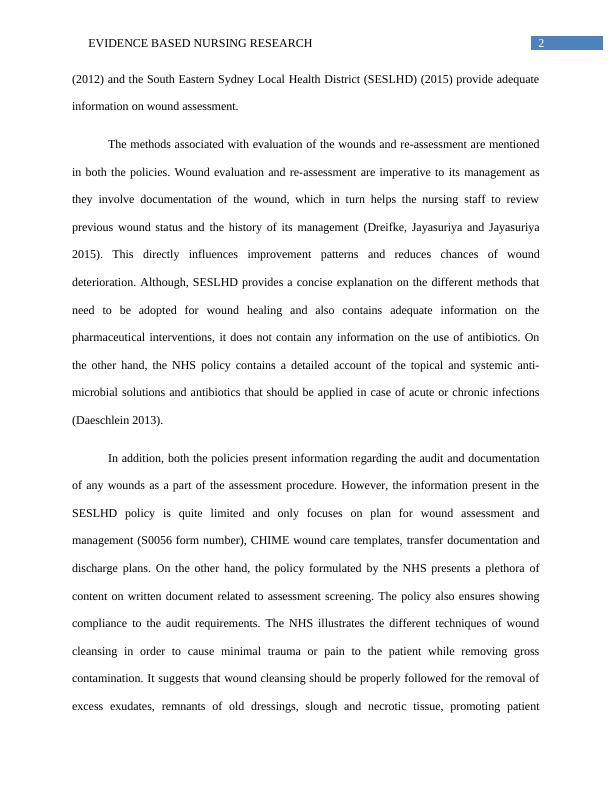Essay on Wound Care Management
12 Pages3193 Words649 Views
Added on 2020-04-15
Essay on Wound Care Management
Added on 2020-04-15
ShareRelated Documents
Running head: EVIDENCE BASED NURSING RESEARCHWound ManagementName of the StudentName of the UniversityAuthor Note

1EVIDENCE BASED NURSING RESEARCHIntroductionThe skin is the largest organ of the human body that makes up around 16% of the bodyweight. It has several functions, related to immunity, regulation of temperature regulation,production of vitamins and sensation. A disruption of the normal structure and function of theskin results in wound formation (Dargaville et al. 2012). This essay will elaborate on twodifferent procedures or policies for wound care management. The first one is ‘WoundManagement Policy” by the Rotherham Doncaster and South Humber, NHS. The other policythat will be discussed in the essay is the “Wound: Wound assessment and Management” bySouth Eastern Sydney Local Health District. These policies and procedures refer to thetechniques that need to be followed for assessing and managing the incidence of several kinds ofwounds. Wound healing can be defined as a complex process that involves natural response forrestoration of injured tissues. It occurs due to interplay of interactions between a series of cellularevents, which reconstruct and restore the injured tissues of the skin. This paper will furtherillustrate the similarities and differences between the abovementioned policies and will shed lighton the more rigorous policy, based on evidences. Similarities and Differences between two policiesWound care management encompasses a series of techniques and interventions that arefollowed by healthcare professionals in order to prevent the wound from getting severe.Therefore, a prior assessment of the wound that involves collection of patient information,observing the wound, surveying the patient and identifying relevant data from the patient’smedical history is essential (Pilen et al. 2012). Both the wound management policies, the NHS

2EVIDENCE BASED NURSING RESEARCH(2012) and the South Eastern Sydney Local Health District (SESLHD) (2015) provide adequateinformation on wound assessment. The methods associated with evaluation of the wounds and re-assessment are mentionedin both the policies. Wound evaluation and re-assessment are imperative to its management asthey involve documentation of the wound, which in turn helps the nursing staff to reviewprevious wound status and the history of its management (Dreifke, Jayasuriya and Jayasuriya2015). This directly influences improvement patterns and reduces chances of wounddeterioration. Although, SESLHD provides a concise explanation on the different methods thatneed to be adopted for wound healing and also contains adequate information on thepharmaceutical interventions, it does not contain any information on the use of antibiotics. Onthe other hand, the NHS policy contains a detailed account of the topical and systemic anti-microbial solutions and antibiotics that should be applied in case of acute or chronic infections(Daeschlein 2013). In addition, both the policies present information regarding the audit and documentationof any wounds as a part of the assessment procedure. However, the information present in theSESLHD policy is quite limited and only focuses on plan for wound assessment andmanagement (S0056 form number), CHIME wound care templates, transfer documentation anddischarge plans. On the other hand, the policy formulated by the NHS presents a plethora ofcontent on written document related to assessment screening. The policy also ensures showingcompliance to the audit requirements. The NHS illustrates the different techniques of woundcleansing in order to cause minimal trauma or pain to the patient while removing grosscontamination. It suggests that wound cleansing should be properly followed for the removal ofexcess exudates, remnants of old dressings, slough and necrotic tissue, promoting patient

3EVIDENCE BASED NURSING RESEARCHcomfort, and facilitating correct wound bed assessment. However, the SESLHD only mentionsthat intensive cleansing of the wound is necessary to prevent further infection. In addition, theways by which heavy colonization can interfere with the stages of wound healing are illustratedin the NHS policy. It further explains about critical colonization, wound swabbing and exudatecontrol. However, the SESLHD fails to provide adequate data on this topic.The NHS policy also proposes to provide education and expert professional advice on thecontrol and prevention of infection to patients, carers, multi-disciplinary groups, and otherhealthcare professionals. It aims to educate on wound management, leg ulcer management andprevention and management of pressure ulcer. It also provides education on the footwear thatneed to be put on to prevent diabetic foot ulcers and formulates training programs that addressescomprehensive dressing selection and wound management (Bakker and Schaper 2012). TheSESLHD policy also proposes providing timely and continuous education and training to thenursing staff would work towards minimising complications, and makes it mandatory for allclinical staff to attend the annual Wound Care Management programs. Therefore, it can bededuced that both policies exert equal importance on the training and education of healthcarestaff. In addition, the NHS policy states that holistic wound assessment should be accurate,precise and patient-centred. This will help in ensuring that the carers as well as the concernedpatients are well acquainted with the potential complications that can arise during woundmanagement. However, no information on holistic assessment or comprehensive treatment planthat meets the needs of the client is present in the SESLHD policy.

End of preview
Want to access all the pages? Upload your documents or become a member.
